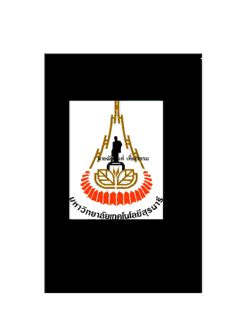
as prebiotic additives on nile tilapia (oreochromis niloticus) PDF
Preview as prebiotic additives on nile tilapia (oreochromis niloticus)
ศักยภาพของการใช้แก่นตะวันเป็นอาหารเสริมชีวนะทางเลือกส าหรับปลานิล. นายณัฐนันท์ เที่ยงธรรม วทิ ยานิพนธ์นีเ้ป็นส่วนหนึ่งของการศึกษาตามหลักสูตรปริญญาวทิ ยาศาสตรดุษฎบี ัณฑิต สาขาวชิ าเทคโนโลยกี ารผลติ สัตว์ มหาวทิ ยาลัยเทคโนโลยสี ุรนารี ปีการศึกษา 2559 THE POTENTIAL USE OF JERUSALEM ARTICHOKE (HELIANTHUS TUBEROSUS) AS AN ALTERNATIVE PREBIOTIC FOR NILE TILAPIA (OREOCHROMIS NILOTICUS) Nattanan Tiengtam A Thesis Submitted in Partial Fulfillment of the Requirements for the Degree of Doctor of Philosophy in Animal Production Technology Suranaree University of Technology Academic Year 2016 V ACKNOWLEDGEMENTS I would like to say that I am indebted to many people for making the time working on my Ph.D. an unforgettable experience. First of all, I would like to express my deepest appreciation to my advisor, Assoc. Prof. Dr. Surintorn Boonanuntanasarn for providing me the opportunity to study towards my Ph.D. degree in Animal Production Technology, and whose continuous guidance, unconditional support and encouragement helped me complete this thesis. I am very grateful to my advisory committee members, Assoc. Prof. Dr. Nontawith Areechon, Department of Aquaculture, Kasetsart University, Bangkok, Assoc. Prof. Dr. Pramote Paengkoum, Asst. Prof. Dr. Sutisa Khempaka, Asst. Prof. Dr. Amonrat Molee and Dr. Samorn Ponchunchoovong, School of Animal Production Technology, Suranaree University of Technology, Nakhon Ratchasima, for their constructive comments, beneficial suggestions and productive advice to my research. I would like to give special thanks the Director of Aquaculture Research Institute, University of Idaho, Idaho, USA, Prof. Dr. Ronald Hardy for giving me the opportunity to work for the first time with rainbow trout, assisting with spawning, egg incubation, and making experimental feeds using trout. The techniques I learned were very useful when applied to my studies with tilapia in Thailand. I would also like to give special thanks to Prof. Dr. Marisol Izquierdo and Prof. Dr. Lidia Robaina for providing me the great opportunity to carry out the VI research in their laboratory at the Aquaculture Research Group, ECOAQUA Institute, University of Las Palmas de Gran Canaria, Gran Canaria, Spain. Their great support, kindness, encouragement and guidance helped me throughout of the experiment. I would also like to give special thanks the Vice-President of the University Council of Nakhon Phanom University, Nakhon Phanom, Dr. Paitoon Ponsana for his great support in enabling me to conduct my research and finish the dissertation. I am also indebted to the Head of the Department of Fisheries, Mr. Poolsap Sirisant, Nakhon Phanom University, for his unflagging support and encouragement. I would like to thank the staff of the fisheries group, from the University Farm and the Center of Scientific and Technology Equipment, and my friends in Animal Production Technology, Suranaree University of Technology, for their helpful suggestions. This research would have never happened without financial support. I would like to express my gratitude to the Thailand Research Fund (TRF) for providing me with the Royal Golden Jubilee (RGJ) Ph.D. Scholarship (Grant No. PHD/0155/2553) for my study. Finally, I want to express my love and gratitude to my beloved parents who are always on my mind, my brothers and also my girlfriend for their precious spirit, love and care throughout my life, and for their understanding and encouragement throughout my thesis. Nattanan Tiengtam VII CONTENTS Page ABSTRACT IN THAI ................................................................................................... I ABSTRACT IN ENGLISH .......................................................................................... III ACKNOWLEDGEMENTS ......................................................................................... V CONTENTS ............................................................................................................... VII LIST OF TABLES .................................................................................................... XIII LIST OF FIGURES................................................................................................. XVII LIST OF ABBREVIATIONS ................................................................................ XVIII CHAPTER I INTRODUCTION ............................................................................................. 1 1.1 Research objectives ...................................................................................... 4 1.2 Research hypothesis ..................................................................................... 4 1.3 Scope of the study ........................................................................................ 4 1.4 Expected results ............................................................................................ 5 1.5 References .................................................................................................... 6 II LITERATURE REVIEW ............................................................................... 10 2.1 Culture of Tilapia ....................................................................................... 10 2.2 Prebiotics .................................................................................................... 14 2.2.1 Definition of prebiotics .................................................................... 14 2.2.2 The use of prebiotics in fish culture ................................................. 16
Description: